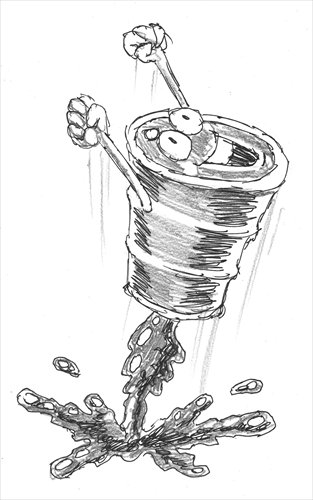OPEC output plan based on maintaining market dominance
Oil prices unlikely to stay at current low level for long

Illustration: Peter C. Espina/GT
International oil prices saw a strong rebound in April, leading to more optimistic market sentiment. If the Organization of the Petroleum Exporting Countries (OPEC), which produces around 30 percent of the world's oil, had chosen to cut production at that point, international oil prices would have increased further.
However, the 12-nation oil cartel decided to maintain its production levels.
Data from OPEC showed that oil production in Saudi Arabia, the world's largest oil exporter, actually increased to 10.31 million barrels per day in April, the highest in nearly 30 years. Saudi Arabia is also planning to raise the number of its drilling rigs to as many as 250 in 2016 from the current 212.
Also, at a meeting on Friday, OPEC decided to leave its current output levels unchanged at 30 million barrels per day, shattering hopes that international oil prices might see a further recovery.
The current low oil prices have cost Saudi Arabia billions of dollars, so why does it choose to maintain its output? In my opinion, there are various reasons.
First, shale energy producers from the US have partly fueled the current supply glut, posing a threat to OPEC countries' interests. By maintaining low oil prices, Saudi Arabia aims to put pressure on shale producers, which are burdened by higher costs. Also, as shale energy is capital intensive, maintaining lower oil prices increases risks for shale investors and dampens their motivation. Though OPEC will not be able to force out shale energy, it could teach future shale energy investors a lesson on the risk of shale investment.
Second, the technology for electric cars and energy storage, together with renewable energy sources, offer substitutes for oil and could pose a real threat to oil prices in the future. High oil prices have pushed the development of these technologies in recent years. By maintaining low oil prices, Saudi Arabia can dampen companies' willingness to invest in these technologies and possibly slow down the progress of these technologies.
Ali al-Naimi, Saudi Arabia's oil minister, said earlier this month that the country may phase out the use of fossil fuels by the middle of this century. If Saudi Arabia truly believes this, it might explain why the country wants to maintain high production despite the low prices. We all know that world oil reserves are still good for 40 years. Does the country's effort aim to fully exploit its oil reserves before fossil fuels are replaced?
For China, the world's largest oil consumer and importer, low oil prices offer many perks. Low oil prices help to reduce overall industrial costs, especially for the transportation and logistics sectors, which could also serve as a boost for the economy.
China is expected to import over 60 percent of its oil this year, and the ratio is expected to increase further in the coming years.
Given the current low oil prices, China can increase its strategic oil reserves at a much lower cost. Low oil prices also present good opportunities for Chinese firms to acquire energy assets overseas.
However, low oil prices could have a negative impact on the development of electric car and energy storage technologies in China. If international oil prices remain low for a long time, Chinese automakers will be less motivated to invest in these areas and consumers will be less motivated to buy such products. But as long as the government continues its supportive measures, the negative impact of low oil prices can be balanced.
The price of Brent crude has been around $63 per barrel in the past few days. Some research institutions predict that Brent will remain around $60 per barrel in the next 10 years, but others have warned that oil prices could soar to $200 per barrel if investment in the sector remains low.
Low oil prices will lead to more demand and a fall in global supplies before the market reaches a new equilibrium. Though OPEC countries are still maintaining production levels, the world's major oil companies have been cutting investments. At the same time, shale producers in the US are also reducing capacity, raising the prospects of lower supply and higher oil prices in the future.
Shale oil is a direct substitute for oil and affects oil prices. But many shale companies are losing money at the current price levels. There have been estimates that international oil prices need to be $76 to $77 per barrel for average shale oil producers to break even. There have been signs that shale oil producers are cutting losses, such as by suspending production at high cost wells.
Geopolitical events are also key factors for oil prices. The stability of most OPEC and gulf countries relies on keeping fiscal revenues steady, which requires about $80 per barrel.
If oil prices remain at the current level for a long time, it could lead to instability, which in turn would bump up oil prices.
Therefore, unless OPEC producers make some changes, I don't think they will be able to afford the current effort to maintain low oil prices for long.
The author is the director of the Collaborative Innovation Center for Energy Economics and Energy Policy at Xiamen University. bizopinion@globaltimes.com.cn